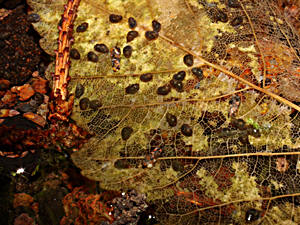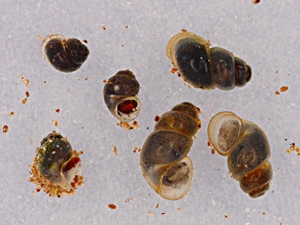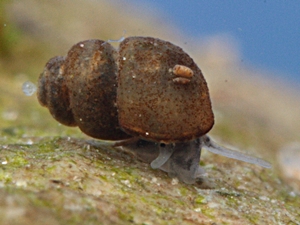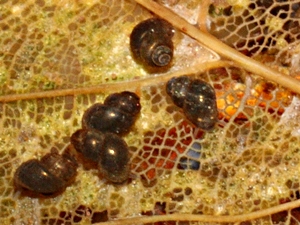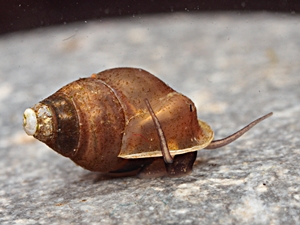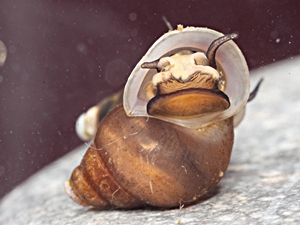Spring
Snails
(Amnicolidae)
| |
| Superfamily
Rissooidea |
| Family
Amnicolidae (Spring snails) |
Subfamily
Amnicolinae (Spring snails)
 Genus Bythinella (Spring snails) Genus Bythinella (Spring snails)
 Genus Marstoniopsis Genus Marstoniopsis
Subfamily Emmericiinae (Spring snails)
 Genus Emmericia
(Spring snails) Genus Emmericia
(Spring snails) |
| Family
Hydrobiidae (Mud snails) |
Subfamily
Hydrobiinae
 Genus
Peringia
(Laver spire snails) Genus
Peringia
(Laver spire snails)
Subfamily
Belgrandiinae
(Spring snails)
 Genus Belgrandiella (Spring snails) Genus Belgrandiella (Spring snails)
 Genus Sadleriana (Spring snails) Genus Sadleriana (Spring snails)
 Genus Bythiospeum (Fountain snails) Genus Bythiospeum (Fountain snails)
Subfamily
Tateinae
 Genus Potamopyrgus
(New Zealand mud snails) Genus Potamopyrgus
(New Zealand mud snails)
Subfamily
Pyrgulinae
 Genus Pyrgulina Genus Pyrgulina |
| Family
Lithoglyphidae (Gravel snails) |
Subfamily Lithoglyphinae
 Genus
Lithoglyphus (Gravel snails) Genus
Lithoglyphus (Gravel snails) |
| Family
Bithyniidae |
| Table: Summary of the described families. |
|
Spring snails are a very diverse family of small to tiny snails inhabiting
fresh or brackish water, also appearing on humid ground near the coast. Very few
species also actually are found in the sea, on muddy ground among seaweed. It is
estimated there are about 300 species in North and South Europe, about 1000
species worldwide, in Australia alone 280 species are mentioned. In Central
Europe many spring snail species inhabiting ground water, caves or springs are
limited to one single geographic finding site, which means a very large
ecological threat to those species.
 Systematics of Gastropoda: Clade Caenogastropoda: Amnicolidae.
Systematics of Gastropoda: Clade Caenogastropoda: Amnicolidae.
Spring Snails (Amnicolinae)
In Central and South Europe about 40 species of spring snails are found, of
which the five most important German species are defined mainly by anatomic
characters, but are difficult to tell apart by shell characters. Often, the
single species can only be told apart by the finding location, as they are
restricted to a very narrow area. This does lose importance in a growing fashion,
as for example in Austria there are often several species of spring snails in
one place usually restricted to a narrow finding area.
The colour of spring snail shells often appears dark brown or green. This is
due to diatoms (brown) and green algae growing on the shell surface.
Distribution of spring snail species often happens by insects capable of flying,
on which the snails have laid eggs. Spring snails live on diatoms, blue and
green algae which they graze from the ground, as well as on detritus - decaying
organic matter.
Accustomed to constantly low water temperatures, spring snails are
cold-stenothermal creatures. They almost exclusively live on springs and in the
uppermost areas of streams. The presence of spring snails is an indicator for
very clean water; in the springs of clean streams sometimes more than 1000
snails can be found per square metre.
Spring snails are crenobionts, which means the are specialist with a very low
ecological amplitude, which react to the slightest difference in environmental
conditions, their density decreasing or the population disappearing altogether.
On the other hand, spring snails are very well adapted to the extreme habitat of
springs.
Spring snails are usually threatened by fountain constructions around the
springs they live in, by agricultural use as watering place for cattle. Also
drainage and ground water descent are a large problem to spring snails, and
sadly so is overfertilisation, resulting in the Eutrophication also of springs.
 Eutrophication.
Eutrophication.
Additionally, global warming results in the water temperatures of springs
rising, which means, the cold-stenothermous populations of spring snails
generally decrease.
| |
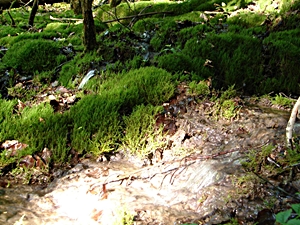
Limestone tuff spring near Fischbach in the Rhön mountains.
Habitat of the Rhön spring snail (Bythinella compressa).
Picture: J. Gombert (Source). |
 Umweltschutz-News: Klimawandel bedroht
Weichtier des Jahres 2008, die österreichische Quellschnecke. (In German)
Umweltschutz-News: Klimawandel bedroht
Weichtier des Jahres 2008, die österreichische Quellschnecke. (In German)
 Naturschutz.at: Die Österreichische Quellschnecke ist das Weichtier des
Jahres. (in
German)
Naturschutz.at: Die Österreichische Quellschnecke ist das Weichtier des
Jahres. (in
German)
 Naturschutzgroßprojekt Thüringer Rhönhutungen: Feuchtlebensräume - Naturnahe
Quellen und Kalk-Flachmoore. (In German)
Naturschutzgroßprojekt Thüringer Rhönhutungen: Feuchtlebensräume - Naturnahe
Quellen und Kalk-Flachmoore. (In German)
| Distribution Area (Germany) |
Name |
| North Alps, Allgäu, Lech and Isar area |
Bythinella bavarica |
| East Alps and Sudetes, Alpine foothills |
Bythinella austriaca |
| Rhön and Vogelsberg |
Bythinella compressa |
| West Germany, Lower Rhine, Sauerland |
Bythinella dunkeri |
| Black Forest |
Bythinella badensis |
|
Austrian Spring Snail - Bythinella austriaca (Frauenfeld
1857)
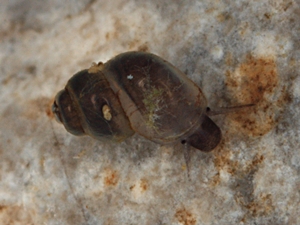
Bythinella cylindrica. |
|
Description: The Austrian spring snail is smaller than Bythinella
bavarica (see below) and almost cylindrical. The whorls of its shell are
flattened at the sides. Also the suture is less prominent. The last whorl takes
two fifths of the shell's overall height.
Dimensions: H: 3.2 mm; W: 1.6 mm. (Abbreviations).
Distribution: The species is an main indicator species for springs and
low mountain streams. It is found in the eastern Bavarian limestone Alps and the
Sudetes, through Moravia, Austria as far as north-eastern Tyrol, Styria,
Carinthia, Northern Slovenia, Hungary and Galicia.
Threat Situation: In Austria the Austrian spring snail is classified
as "Near Threatened" (NT) (see also:
 IUCN Threat Categories).
IUCN Threat Categories).
 Robert A.
Patzner, Naturschutzbund Österreich:
Weichtier des Jahres 2008 - Bythinella austriaca. (In German)
Robert A.
Patzner, Naturschutzbund Österreich:
Weichtier des Jahres 2008 - Bythinella austriaca. (In German)
Bythinella cylindrica (Frauenfeld
1857)
The shell is less slender, the suture noticeably deepened. The whorls are
rounded at the sides, the last whorl takes two thirds of the overall shell
height.
Dimensions: H: 2.6 - 2.8 mm; W: 1.5 - 1.7 mm. (Abbreviations).
Distribution: Northern Alps, eastern Bavarian limestone Alps and their
foot hills. From Munich east through Bavaria, as far as northern Tyrol and
Salzburg country, Pottenstein near Wiener Neustadt (Lower Austria) and the
high terrace near Munich.
According to Reischütz Bythinella cylindrica
is to be seen as a subspecies of Bythinella
austriaca.
Rhön Spring Snail- Bythinella compressa (Frauenfeld 1857)
The Rhön spring snail's shell is oval to bluntly conical, the last whorl
takes four fifths of the shell height. The whorls are strongly rounded at the
sides, the apex is blunted a little obliquely.
Dimensions: H: 2.2 mm; W: 1.5 mm. (Abbreviations).
Distribution: In Germany: Rhön and Vogelsberg mountains in Hesse and
Thuringia. Also present in Austria.
The Rhön spring snail needs constantly cold and unpolluted water (saprobial
value of 1.0) with a temperature of around 7 - 8 °C. It feeds on bacteria
growing on stones and leaves, as well as on decaying organic matter (detritus),
which is grazed from stones, water plants, fallen leaves (picture) and dead wood
lying in the water.
While some time ago the Rhön spring snail was wide spread in the open
landscape shaped by man, today it appears nearly exclusively in spring exits and
some hundreds of metres downstream in the streams of deciduous forest areas. In
intact habitats there may be as many as 50 snails on 25 x 25 cm.
Populations live isolated from each other. With their highly specialized
demands to habitats (see above), populations disappeared are lost forever.
Bavarian Spring Snail - Bythinella bavarica Clessin
1877
Description: The Bavarian spring snail usually is large (for a spring
snail), turricular and conical with rounded whorls, the last of which is widened.
The shell often is green coloured due to algae growing on it. The shell tip (apex)
is small and blunted obliquely, the whorls are separated by a deep suture.
Dimensions: H: 4 mm; W: 2.3 mm; N: 4½ - 5.
(Abbreviations).
Distribution: The Bavarian spring snail is a calciphile species - it
needs limestone ground. Its distribution area spreads over the northern Alps and
the foot hills (Lech and Isar river areas). The Bavarian spring snail can be
found from southern Württemberg as far east as the Inn river and northern Tyrol
in Austria.
 Geyer,
D.: Unsere Land- und Süßwassermollusken, Stuttgart, 1927, S. 165 ff.
Geyer,
D.: Unsere Land- und Süßwassermollusken, Stuttgart, 1927, S. 165 ff.
 Wolfgang
Fischer:
Checklist of Austrian Mollusca.
Wolfgang
Fischer:
Checklist of Austrian Mollusca.
Emmericiinae
Wide Lipped Spring Snail - Emmericia patula (Brumati 1838)
Description: The wide-lipped spring snail has a bluntly conical shell,
the last whorl of which has a distinctive palatal callus. The apertural lip, as
the name states, is folded back to form a wide whitish lip. The whorls grow
fast.
Dimensions: H: 6 mm; W: 4 mm. N: 4½ - 5. (Abbreviations).
Habitat and Distribution: Emmericia patula lives in springs and
rivers rich in limestone.
The species' distribution area spreads along the Italian and Yugoslavian
Adriatic coast from Venetia as far south as Central Dalmatia. In southern France
and Bavaria (Central Franconia), Emmericia patula has been
introduced in 1960; how and where from, is unknown. In the meantime, it has also been
found in Dachau and Munich.
 Wide lipped spring snail (Emmericia patula) from the Tinavo springs near Trieste, Italy.
Wide lipped spring snail (Emmericia patula) from the Tinavo springs near Trieste, Italy.
 Francisco
Welter-Schultes:
Emmericia patula species homepage.
Francisco
Welter-Schultes:
Emmericia patula species homepage.
 Dr. Stefan
Nehring: Neozoa (Makrozoobenthos)
in den deutschen Gewässern - Eine Einführung. (In German).
Dr. Stefan
Nehring: Neozoa (Makrozoobenthos)
in den deutschen Gewässern - Eine Einführung. (In German).
 Molluscs With Immigration Background
(Neobiota).
Molluscs With Immigration Background
(Neobiota).
